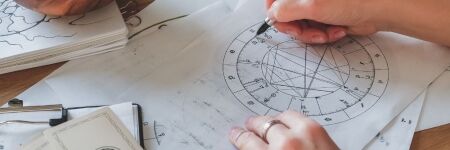The Sextile: A positive aspect
A Sextile forms when two planets are 60° apart (an interval of 2 signs with an orb of 4 degrees).
👉 For example: Venus at 20 degrees Libra and Saturn at 22 degrees Sagittarius = Venus Saturn Sextile.
Like the Trine, a Sextile creates a good interaction, a good relationship between the planets involved, even if they are initially incompatible. They find a way to work together! The Sextile is beneficial, like the Trine, though slightly less powerful. In this case, Venus, the planet of love, would be frustrated or blocked by Saturn’s coldness in a Conjunction, Opposition, or Square. But in a Sextile, like in a Trine, Saturn brings seriousness, loyalty, and stability to Venus’ feelings.
Practical summary of astrological effects
| Trine | Very positive, harmonious aspect |
| Sextile | Positive, harmonious aspect |
| Conjunction | Sometimes harmonious, sometimes tense depending on the planets involved |
| Opposition | Tense, negative aspect |
| Square | "Very" negative or rather very tense aspect! |
With this table, it’s clear and simple! Feel free to let me know in the comments what you think.
Frequently Asked Questions about Astrological Aspects
What are astrological aspects? ▼
Astrological aspects are the angles formed between planets in a natal chart. These angles influence how the planets interact and affect your personality, emotions, and life events. They can be harmonious (like Trines and Sextiles) or challenging (like Squares and Oppositions).
What is the most positive aspect in astrology? ▼
The Trine is considered the most positive aspect in astrology. It occurs when two planets are 120 degrees apart, creating a harmonious flow of energy that enhances creativity, talent, and ease in life.
How do Squares and Oppositions affect my life? ▼
Squares and Oppositions are challenging aspects that create tension and obstacles. However, they also encourage growth, resilience, and the ability to overcome difficulties. These aspects can push you to achieve more and grow as a person.
Can aspects change over time? ▼
The aspects in your natal chart remain constant throughout your life. However, transiting planets can form temporary aspects with your natal planets, influencing your life for a specific period. These are known as transits.
🔴 Editorial Insight: A complex study...In a birth chart, a native with only positive aspects will likely be "relaxed" and generally happy throughout their life, but they may not push themselves to achieve more. They might live a "comfortable" life without challenges, big projects, or much responsibility—they will "go with the flow," as they say.
It has been observed that "Squares" and "Oppositions" bring internal tensions and difficulties in life, but they also help a person push beyond their limits, take on challenges, grow, and achieve personal and social fulfillment. These are dynamic aspects. As you can see, an astrological study requires many years of experience and practice. If you want to learn more about your birth chart, schedule an appointment with one of our astrologers.
|
Did you like this article? Then you’ll love:










 Aries
Aries  Taurus
Taurus  Gemini
Gemini  Cancer
Cancer  Leo
Leo  Virgo
Virgo  Libra
Libra  Scorpio
Scorpio  Sagittarius
Sagittarius  Capricorn
Capricorn  Aquarius
Aquarius  Pisces
Pisces 








Did you like this article?
Want to know more 🤔 ?
Write directly to the authorSusanTaylor !
Ask Susan a question
Want to share your thoughts? Leave a comment